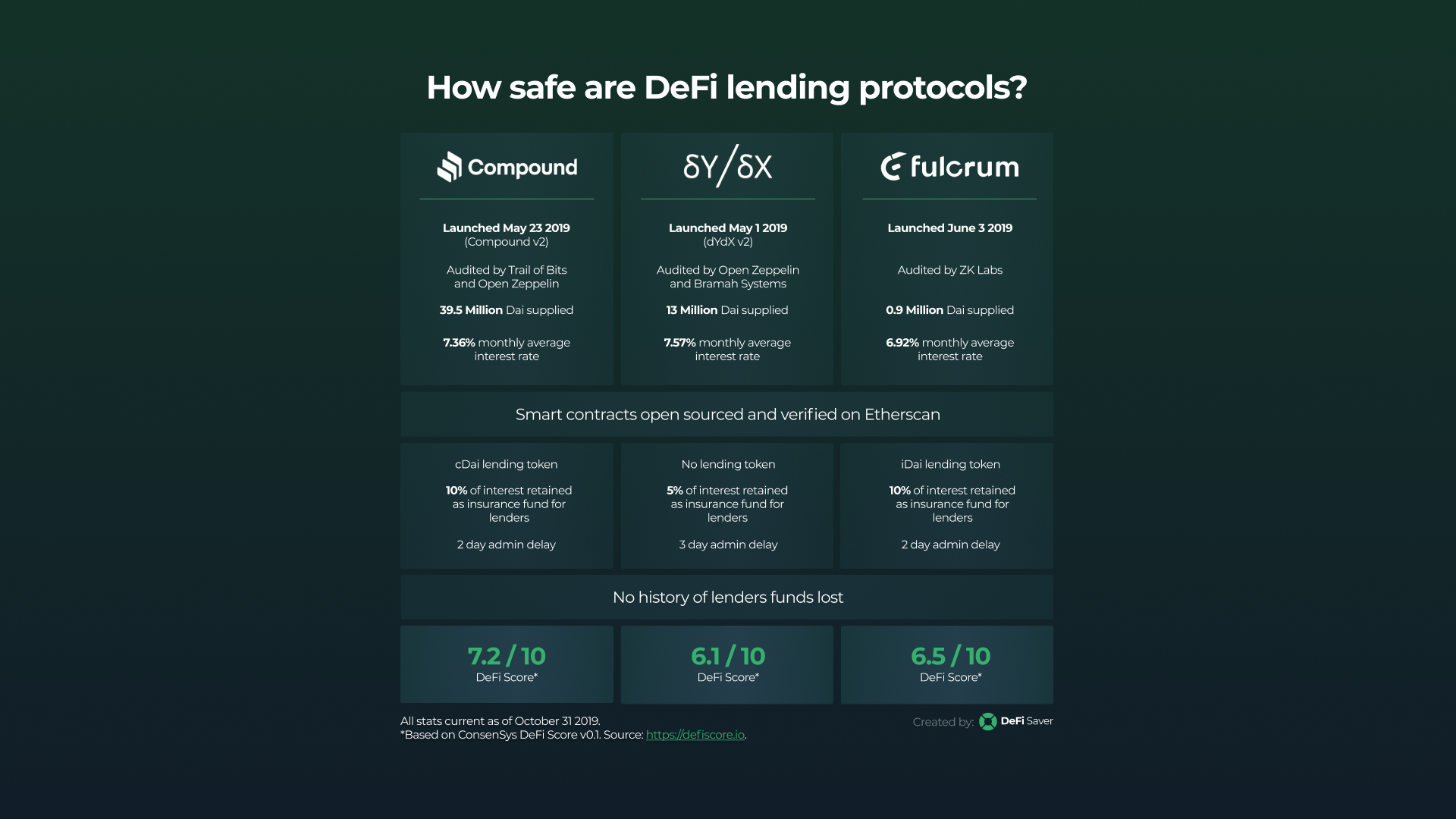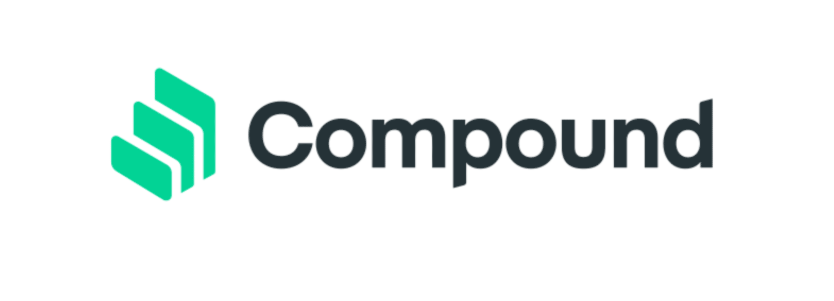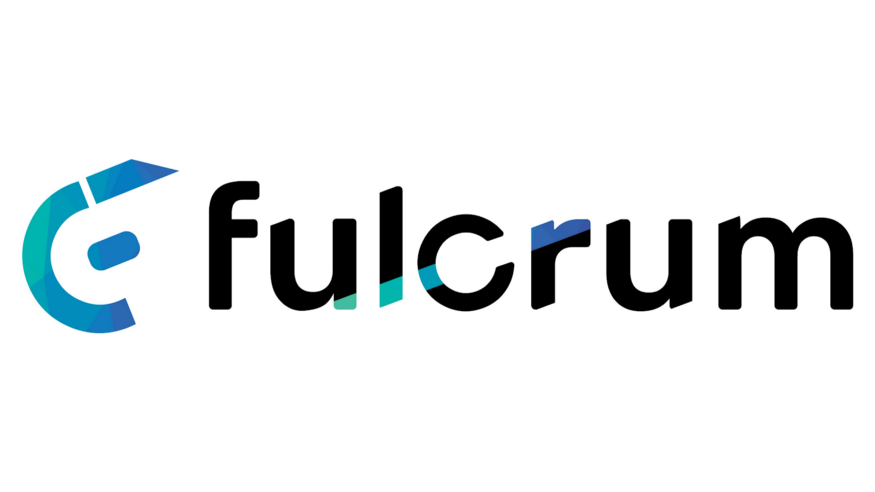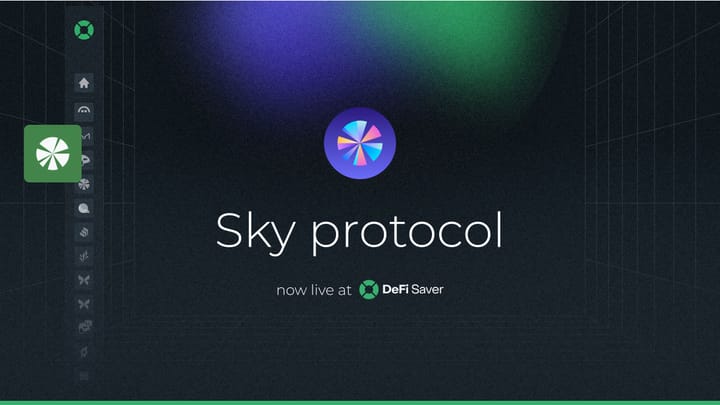How safe are DeFi lending protocols? (featuring Compound, dYdX and Fulcrum) [Infographic]
Lending has quickly become one of the most popular activities in DeFi, and it’s easy to see why — it offers an attractive, but also…
![How safe are DeFi lending protocols? (featuring Compound, dYdX and Fulcrum) [Infographic]](/content/images/size/w1200/downloaded_images/How-safe-are-DeFi-lending-protocols---featuring-Compound--dYdX-and-Fulcrum---Infographic-/1-C3bga25iChPg3mtESA9t1g.png)
Lending has quickly become one of the most popular activities in DeFi, and it’s easy to see why — it offers an attractive, but also guaranteed way to earn interest on your funds. It’s a path to a profit that may or may not happen by simply holding your crypto and it comes as no surprise that there is currently over 50 Million Dai supplied for lending within Compound, dYdX and Fulcrum.
But how do these lending protocols compare and just how safe are they? The infographic below provides an overview of some key points and differences between them.👇

However, if you would like to dig deeper, let’s take a closer look at each of our three favourite lending protocols.
Compound
Compound has grown to become an incredibly popular DeFi protocol, with Maker currently being the only one with a higher total value of locked funds.

The current version of Compound (v2) launched on May 23rd and the source code of their smart contracts is available on their GitHub. As of now, the smart contracts have been audited by Trail of Bits and Open Zeppelin, with no critical issues found. All of their current, mainnet smart contracts are also verified on Etherscan.
Since our focus today is on lending Dai, we should note that Compound almost dwarfs dYdX and Fulcrum in this regard with over 30 Million Dai supplied. As a safety measure, the protocol retains 10% of interest earned as an insurance fund for lenders to mitigate the risk of any potential borrowers’ liquidations gone wrong.
Version 2 of the protocol introduced use of cTokens, which means that you now receive cDai in return for supplied Dai and the interest compounds on a per block basis. The Compound team also recently introduced a 2 day admin delay on any manual adjustments to the protocol, eliminating the only shortcoming Compound had compared to the other two protocols.
The sheer amount of funds, both lent and borrowed, combined with the number of users and the fact that no user ever lost funds so far cannot be ignored when talking about Compound. These are some of the main reasons that Compound received the highest DeFi Score of the three: a 7.2/10, based on ConsenSys’ v0.1 open source methodology.
dYdX
The initial version of the dYdX protocol was launched more than 2 years ago, in September 2017, but their current iteration which introduced lending wasn’t introduced until May 1st this year. All of their smart contracts are also open source and available on GitHub. The code has been audited by Open Zeppelin and Bramah Systems and you can find the current smart contracts as verified on Etherscan.

While we previously mentioned that Compound is far ahead of others in terms of supplied funds, dYdX has been no slouch and has seen constant growth since launch. Currently, there’s around 13 Million Dai supplied, an amount not to be ignored. While dYdX hasn’t implemented lending tokens as of now, they also retain 5% of the interest within the protocol as lenders insurance and a precautionary measure in case of issues with borrowers’ liquidations. What’s more, the protocol also has a 3-day delay on any potential admin-made adjustments.
Although they currently hold a slightly lower DeFi Score of 6.1/10, we see no reasons against using dYdX. Just like with the other two protocols, there were also no records of lender’s funds being lost on dYdX.
Fulcrum
Fulcrum launched on June 3rd this year and it’s built on top of the bZx base protocol, which was introduced in September 2018. Both Fulcrum and bZx have been audited by ZK Labs and their smart contract code is open source. If you want to check their current smart contracts, you can find them as verified on Etherscan.

Fulcrum is another protocol that integrated use of lending tokens, iTokens in this case, which means that you get iDai in return for supplying Dai to Fulcrum. The only difference here is that Fulcrum is designed in a way that interest gets compounded every second. The protocol also retains 10% of the interest within the protocol as lenders insurance in case of liquidation issues.
They recently introduced a 2-day admin delay for any manual adjustments of the protocol’s parameters, too. However, while the project doesn’t lag behind any of the other protocols in a technical sense, its adoption has been slower, which reflects in the currently supplied Dai amount of around 940 000.
The lower liquidity is the main reason for the DeFi Score not being higher than the currently received 6.5/10, so it shouldn’t necessarily be considered as an indicator of the protocol’s safety.
Is there a definite choice?
We believe there isn’t and this is why you can find all three protocols integrated in Smart Savings (where you can move supplied funds in 1-tx between protocols based on interest rate changes🤯). While the sheer amount of funds locked within Compound may inspire additional confidence, there were simply never any unexpectedly lost funds with any of these protocols.
Since we focused on Dai today, we should also note that DSR (Dai Savings Rate) might become the go-to choice for lending, once it’s introduced with the launch of MCD on November 18. We are yet to see how it plays out in terms of interest rates, though, but using a native Maker feature instead of moving to another protocol could be the best option in terms of security.
The main takeaway for us is to always do as much research as needed to make you feel comfortable with using a specific protocol. To help you out on this journey, all the data shared in previous paragraphs links to appropriate sources, with some more included below.
In case you would like to discuss anything with us, feel free to join us in the DeFi Saver discord. And if you feel ready to start lending with these protocols today, you can log into Smart Savings with your wallet of choice (MetaMask, Ledger, Trezor and mobile wallets are all supported) and start earning that sweet interest today.
Sources and additional materials
- DeFi Score: https://media.consensys.net/introducing-the-defi-score-an-open-source-methodology-to-evaluate-code-and-financial-risk-in-defi-6c8616de791c (introduction) & https://defiscore.io/ (current v0.1 scores)
- Historical Dai lending rates: https://loanlist.io/asset/dai
- Protocol statistics: https://defipulse.com/
- Stages of decentralization of DeFi protocols: https://medium.com/bzxnetwork/how-decentralized-is-defi-a-framework-for-classifying-lending-protocols-a34f02c14f5c
- Centralized points of failure in DeFi: https://medium.com/@ameensol/what-you-should-know-before-putting-half-a-million-dai-in-compound-fafdb2645f77
Stay connected:
🌍: DeFiSaver.com
💬: Official Discord
📢: Official Twitter account



